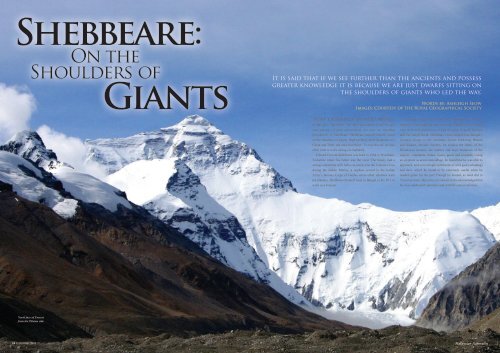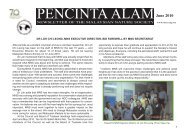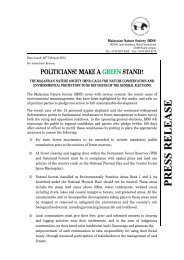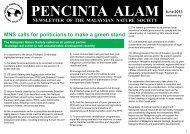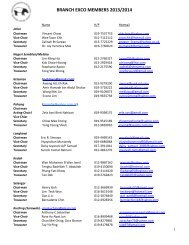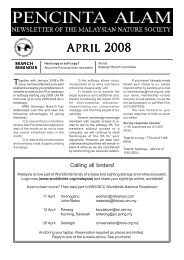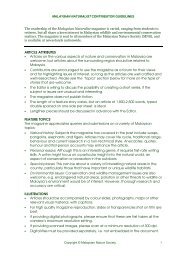SHEBBEARE: On The Shoulders of GIANTS - Malaysian Nature ...
SHEBBEARE: On The Shoulders of GIANTS - Malaysian Nature ...
SHEBBEARE: On The Shoulders of GIANTS - Malaysian Nature ...
Create successful ePaper yourself
Turn your PDF publications into a flip-book with our unique Google optimized e-Paper software.
Shebbeare:<br />
<strong>On</strong> the<br />
<strong>Shoulders</strong> <strong>of</strong><br />
Giants<br />
It is said that if we see further than the ancients and possess<br />
greater knowledge it is because we are just dwarfs sitting on<br />
the shoulders <strong>of</strong> giants who led the way.<br />
Words by: Ashleigh Seow<br />
Images: Courtesy <strong>of</strong> the Royal Geographical Society<br />
That certainly would seem to<br />
be the case with MNS. <strong>The</strong> early presidents <strong>of</strong> the Society<br />
were persons <strong>of</strong> great achievement, not least our founding<br />
president E. O. Shebbeare. Shebbeare himself literally stood<br />
on the shoulders <strong>of</strong> giants. High on Mt Everest he gazed over<br />
China and Tibet, not once but twice. To top that <strong>of</strong>f, he also<br />
<strong>of</strong>ten rode to work sitting on elephants.<br />
Edward Oswald Shebbeare was born in 1884 in Wykeham,<br />
Yorkshire where his father was the vicar. <strong>The</strong> family had a<br />
strong connection with India; an uncle won the Victoria Cross<br />
during the Indian Mutiny, a nephew served in the Indian<br />
Army’s famous Corps <strong>of</strong> Guides while other relatives were<br />
tea planters. Shebbeare himself went to Bengal in his 20’s to<br />
work as a forester.<br />
Like many young men <strong>of</strong> his time, Shebbeare showed an<br />
interest in the outdoors and his work enabled him to spend<br />
time in the hills and forests <strong>of</strong> Eastern India. Imagine Mowgli<br />
and <strong>The</strong> Jungle Book. Shebbeare’s beat ranged from Bengal’s<br />
lowland forests to the mountain forests bordering Bhutan<br />
and Sikkim. Besides forestry, he studied the fishes <strong>of</strong> the<br />
Himalayan streams, the reptiles and large mammals <strong>of</strong> the<br />
region – elephants, rhinos, tigers, gaurs and leopards. Using<br />
an elephant as scent camouflage, he found that he was able to<br />
approach, and even mingle with herds <strong>of</strong> wild gaur (seladang)<br />
and deer, which he found to be extremely useful when he<br />
needed game for the pot! Though he hunted, as most did in<br />
Victorian times, the critics <strong>of</strong> colonial India acknowledged that<br />
he was a dedicated naturalist and wildlife conservationist.<br />
North face <strong>of</strong> Everest<br />
from the Tibetan side.<br />
34 September 2010<br />
<strong>Malaysian</strong> Naturalist
Shebbeare in Tibetan clothes and umbrella.<br />
Early Discoveries<br />
Travelling in the forests with his elephants, an activity he called “ghooming”, he<br />
observed animals and their natural behaviour. He saw the Golden Langur Trachypithecus<br />
geei in 1907, half a century before it was taxonomically described in 1953. We tend to<br />
think <strong>of</strong> the rhino as a slow lumbering beast but Shebbeare revealed it is in fact a fast<br />
mover and can hurdle a fallen tree like a horse! Ghooming came with its risks with<br />
tigers that sometimes attacked the elephants. <strong>The</strong> experienced rider, he tells us, stays<br />
on the elephant and lets it deal with the tiger. Inexperienced riders jump <strong>of</strong>f which<br />
is what the tiger wants them to do. If the tiger jumps on the elephant’s head though,<br />
Shebbeare advises that “one must clout it with whatever is at hand” even if this is just<br />
an umbrella.<br />
Working with the hill tribes <strong>of</strong> the Himalayas enabled him to observe their life and<br />
customs though he never forgot that he was a “sahib”. Shebbeare’s experience with<br />
tribesmen and animals led him to be appointed Transport Officer on the 1924 British<br />
Everest Expedition, one <strong>of</strong> the most famous expeditions in mountaineering history. It<br />
is possible that the legendary climbers George Mallory and Andrew Irvine reached the<br />
summit nearly 30 years before Sir Edmund Hillary.<br />
Shebbeare returned to Everest in 1933 as Deputy Leader <strong>of</strong> the British expedition<br />
and despite his age climbed the North Face to 7100 metres. This was on the harder<br />
Tibetan side <strong>of</strong> the mountain. His organisational flair and his ability to speak to the<br />
Sherpa porters in their own dialect led to a demand for his services. He also supervised<br />
the logistics <strong>of</strong> the German expeditions to Kanchenjunga, the third highest peak in the<br />
world and one <strong>of</strong> the remotest. At a time <strong>of</strong> growing Anglo-German rivalry before the<br />
World War, being asked to assist the Germans was the highest possible praise.<br />
A Himalayan expedition in those times was logistically as well as physically<br />
demanding. Nowadays, mountaineers fly to Nepal to start their climbing. In Shebbeare’s<br />
time, a hundred porters, cooks and climbers with 300 mules walked from India to Tibet<br />
over two months in a mile long column.<br />
Shebbeare became a<br />
founding member <strong>of</strong> the<br />
Himalayan Alpine Club<br />
whose leader, General<br />
Bruce, was said to have<br />
been the inventor <strong>of</strong><br />
short trousers. Bruce cut<br />
<strong>of</strong>f the lower legs <strong>of</strong> his<br />
trousers which rubbed<br />
against his knees when<br />
carrying a Gurkha on his<br />
back while hill training.<br />
Shebbeare became a founding member <strong>of</strong> the Himalayan<br />
Alpine Club whose leader, General Bruce, was said to have been<br />
the inventor <strong>of</strong> short trousers. Bruce cut <strong>of</strong>f the lower legs <strong>of</strong> his<br />
trousers which rubbed against his knees when carrying a Gurkha<br />
on his back while hill training. Shebbeare was an unconventional<br />
dresser too and usually wore shorts and canvas shoes without<br />
socks. Photographs <strong>of</strong> Shebbeare on Everest show him clad in<br />
Tibetan clothes wearing a horn shaped hat while other members <strong>of</strong><br />
the expedition are dressed like English country gentlemen.<br />
His relaxed dressing style got him into trouble when he was<br />
on the P & O ships that connected the Empire. Formal dressing<br />
was the accepted etiquette and he shocked the other passengers<br />
by not ‘dressing’ for dinner at the Captain’s table. When criticised<br />
they found him the next evening seated in white tie and tailcoat.<br />
Much pleased they joined him but when everyone got up to leave<br />
they saw below the dinner jacket the usual shorts and Bata shoes<br />
without socks!<br />
Forestry Pioneer<br />
In the early 1900s forestry in India faced a crisis. Since the 19th<br />
century timber, especially teak and sal (Shorea robusta), was<br />
considered a vital export commodity. A rigorous and effective<br />
protection and management <strong>of</strong> forests was instituted which<br />
included removing tribal people from forest reserves as swidden<br />
(slash and burn) cultivation was seen as a threat to the valuable<br />
timber. But over time it was evident that the teak and sal forest was<br />
not regenerating as it should. Manual replanting efforts failed.<br />
Shebbeare knew <strong>of</strong> a traditional system <strong>of</strong> intercropping known<br />
as taungya in which crops are grown next to or under the tree<br />
canopy. He advocated combining this with the tribal swidden<br />
cultivation and bringing the indigenous people back into the forests. After logging the<br />
timber, the land would be burnt and crops planted. Two harvests later the tribes moved<br />
on to new sites allowing the forest to regenerate. He wrote that “fire appears to be the<br />
only real cure…” Today we are aware that fire is a necessary part <strong>of</strong> the regeneration for<br />
many environments. At the time it was radical thinking.<br />
<strong>On</strong>ce the authorities had been persuaded by Shebbeare and others, he started<br />
implementing the scheme. It worked and he later became Conservator <strong>of</strong> Forests. A<br />
history <strong>of</strong> forestry in India says<br />
“E O Shebbeare was a versatile <strong>of</strong>ficer <strong>of</strong> rare ability. He was responsible for<br />
the bold adoption <strong>of</strong> clear felling and taungya method <strong>of</strong> regeneration…His energy<br />
and optimism proved contagious to all his colleagues, with the result that excellent<br />
plantations, certified to be the best in India, <strong>of</strong> sal, teak, champ, and a number <strong>of</strong> other<br />
important species sprang up, almost simultaneously, in most divisions.”<br />
<strong>The</strong>se developments were noticed by other colonies and as a result the taungya<br />
system spread across the globe. Today it is the basic model for almost every agr<strong>of</strong>orestry<br />
system in the tropics.<br />
Throughout his colourful career, Shebbeare never lost his humour and a photograph<br />
that circulated in India at the time showed him working a field on a plough attached to<br />
an elephant.<br />
Malayan Years<br />
But what did Shebbeare achieve in Malaya? As Chief Game Warden, one <strong>of</strong> his main<br />
tasks was the establishment <strong>of</strong> Taman Negara King Edward VII. While the impetus for<br />
the park came from <strong>The</strong>odore Hubback, the actual job fell to Shebbeare in 1938. By 1939<br />
there was a Park HQ at Kuala Tahan and 9 ranger posts from Merapoh to Sg. Spia in the<br />
south. It was another 64 years before Malaysia got its second National Park following<br />
MNS’s efforts at Endau Rompin.<br />
Here, he continued his work with elephants. He once marched an elephant and calf<br />
from Kuala Kangsar over the Main Range to a new life in Taman Negara. <strong>The</strong> journey<br />
was done entirely through jungle up to the shoulder <strong>of</strong> Gunung Yong Yap then through the<br />
ridges and valleys <strong>of</strong> the Ber, Berok and Mu rivers. <strong>The</strong>ir journey, assisted by the Temiar,<br />
took an entire month.<br />
However, Shebbeare’s conservation work was soon to take a back seat to defence. He<br />
was in the Federated Malay States Volunteers and charged with a raising a jungle border<br />
patrol.<br />
His jungle knowledge then led F. Spencer Chapman to ask Shebbeare to remain behind<br />
Japanese lines as a guerilla and he influenced Chapman to set up his first camp just north<br />
<strong>of</strong> Fraser’s Hill. Shebbeare himself lived in a bungalow at the Gap Rest House which gave<br />
him easy access to both sides <strong>of</strong> the Main Range.<br />
However, the rapid Japanese advance cut Shebbeare <strong>of</strong>f from Chapman and he was<br />
captured and interned. Chapman later found the bungalow ransacked and both Shebbeare’s<br />
scientific papers and the Society’s early records were destroyed. Today, little remains <strong>of</strong><br />
the bungalow.<br />
In a Singapore prison Shebbeare was reunited with other MNS members, future<br />
presidents Edgar, Madoc, Molesworth and committee member Gibson-Hill. Amazingly,<br />
considering the poor conditions, they embarked on a lecture programme on Malayan<br />
nature for other detainees and printed “Introduction to the Birds <strong>of</strong> Malaya”, later<br />
published after the war. After the Japanese surrender, Shebbeare’s first act was to tell a<br />
Japanese guard to take <strong>of</strong>f his boots and give them to him. This pair <strong>of</strong> boots remained his<br />
for the next few years!<br />
<strong>The</strong> Game Department could not immediately be reconstituted partly because rangers<br />
had been killed or could not be located. <strong>The</strong> dedication <strong>of</strong> Shebbeare’s rangers was<br />
outstanding. In one instance, a ranger, Zainal, refused to leave his ranger post and was<br />
killed by the Japanese. Losing men like these was catastrophic to the Game Department<br />
which Shebbeare headed.<br />
Ironically, Shebbeare warned that wildlife were at a greater risk at that time than ever<br />
before due to the number <strong>of</strong> British <strong>of</strong>ficers keen to ‘bag trophies’. A temporary <strong>of</strong>fice was<br />
set up to register firearms and licenses to have some sort <strong>of</strong> control.<br />
Just when civil administration had been restored, the Emergency started and the forests<br />
became communist hideouts. Taman Negara became a restricted area and game wardens<br />
now had to have military escorts that made their job quite difficult.<br />
By this time, Shebbeare was 65 and he retired and returned to the UK via Bengal<br />
where he met Lord Casey, who was President <strong>of</strong> Bengal. Shebbeare organised a tiger hunt<br />
for Casey and the events became the basis for his most well known<br />
book “Sundar Mooni”, the story <strong>of</strong> an Indian elephant from birth to<br />
maturity. It is a book filled with rare knowledge <strong>of</strong> how elephants<br />
descend a waterfall or how to <strong>of</strong>f load an elephant from a ship to an<br />
island while still <strong>of</strong>fshore.<br />
Casey, used to dealing with powerful figures like Roosevelt and<br />
Churchill, found him to be “a very individual personality – tough and<br />
hard…when we arrived… he was attired in shorts and an old khaki<br />
shirt and his rawhide boots and socks. Someone said that the socks<br />
were overdoing it a bit and he said ‘Oh, you have to cut a bit <strong>of</strong> a<br />
dash on these occasions’.”<br />
In his retirement, Shebbeare settled in Banbury near Oxford and<br />
wrote several books on natural history which continue to be cited<br />
today.<br />
His enduring legacy is the forestry work he did in India and<br />
establishing wildlife sanctuaries, in particular, the Jaldapara rhino<br />
sanctuary which was critical in helping save the <strong>On</strong>e Horned Asian<br />
Rhino from extinction. Even at that time Shebbeare noted that the<br />
rhino was threatened mainly due to the demand for it in traditional<br />
Chinese medicine. When the sanctuary was established, visitors<br />
went instead to observe the rhino and to take photographs, an early<br />
example <strong>of</strong> eco-tourism. Today one can ride still ride elephants while<br />
watching rhinos at Jaldapara.<br />
How does one judge a life? Perhaps the assessment <strong>of</strong> those<br />
who knew him is best. His nephew Robert observed in the 1930s<br />
that the name <strong>of</strong> “Shebbeare Sahib” was known across the land.<br />
Anthropologists working with the hill people <strong>of</strong> India noted that<br />
the names <strong>of</strong> Shebbeare and some other <strong>of</strong>ficers have entered<br />
the oral histories <strong>of</strong> these people who praised them for their<br />
management <strong>of</strong> forests and stopping illegal logging.<br />
Here in Malaysia, his obituary in the Malayan <strong>Nature</strong> Journal<br />
recorded that, “with his passing the Society and Malayan nature in<br />
general has lost a true friend”.<br />
E.O. Shebbeare was MNS’ first president. Here is a complete list<br />
<strong>of</strong> the men who have filled the honorable position.<br />
<strong>The</strong> Past Presidents <strong>of</strong> MNS<br />
E.O. Shebbeare 1940-1942<br />
A.T. Edgar 1948-1950<br />
Dr. B.D. Molesworth 1950-1951<br />
G.C. Madoc 1951<br />
A.T. Edgar 1951- 1952<br />
Dr. J.A. Reid 1956 - 1959<br />
J. Wyatt-Smith 1959 - 1962<br />
Dr. H.E. McClure 1962 - 1963<br />
Dr. P.R. Wycherley 1963 - 1964<br />
Dr. G.A. Watson 1964 - 1965<br />
Wong Yew Kwan 1965 - 1966<br />
Dr. E. Balasingam 1966 - 1967<br />
Ken Scriven 1967 - 1968<br />
Pr<strong>of</strong>. N.S.Haile 1968 - 1969<br />
Dr. T.C. Whitmore 1969 - 1970<br />
Dr. P.R. Wycherley 1970 - 1971<br />
Dr. J.A. Bullock 1971 - 1972<br />
Mohd Khan B. Momin Khan 1972 - 1974<br />
Dr. Francis Ng 1974 - 1975<br />
Mod Khan B. Momin Khan 1975 - 1978<br />
Dr. Salleh Mohd Nor 1978 - 2006<br />
V. Anthony Conrad Sebastian 2006 - 2008<br />
Tan Sri Dr. Salleh Mohd Nor<br />
2008 – present<br />
36 September 2010<br />
<strong>Malaysian</strong> Naturalist


